Pump Handbook by Igor J. Karassik, Joseph P. Messina, Paul Cooper, Charles C. Heald - 3rd edition
Подождите немного. Документ загружается.

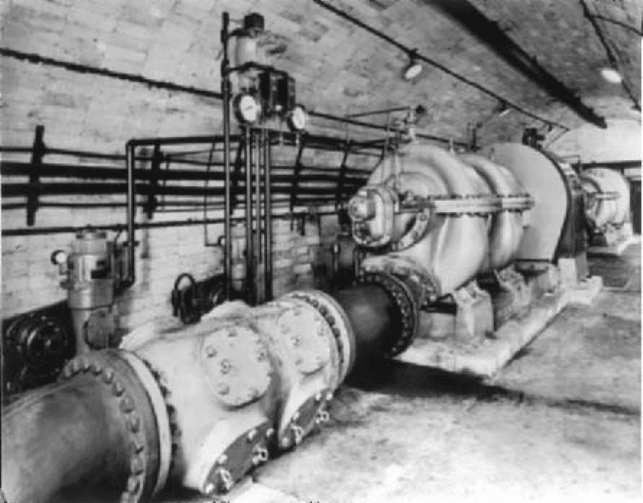
9.208 CHAPTER NINE
FIGURE 13 A sealed room in a coal mine housing three 1000 HP (746 kW) bronze constructed pumps (Hazleton
Pumps, Inc.)
example, if two 5000-gpm (1136-m
3
/h) pumps are discharging into a common discharge
line against a static head of 80 ft (24 m) and a frictional head of 60 ft (18 m), the frictional
head will be only 15 ft (4.6 m) when one pump operates alone at 5000 gpm (1136 m
3
/h).
The total head will now be only 95 ft (69 m), and the single pump will carry out to a much
higher capacity. Unless sufficient NPSH is available for the single-pump runout point, the
pump will cavitate. Although the two pumps should be selected for 5000 gpm (1136 m
3
/h)
at 140 ft (43 m) total head, the required NPSH should be determined not at 5000 gpm
(1186 m
3
/h) but at the capacity corresponding to the intersection of the pump and system
curves.
High-Head Pumps For high-head pumps, 1000 ft (305 m) head or more, the risk of cav-
itation for single-pump operation on a parallel system is less than for low-head pumps.
For example, if the static head is 1000 ft (305 m) and the frictional head is 60 ft (18 m)
when two 5000-gpm (1136-m
3
/h) pumps are operating, the total head will decrease from
1060 ft (323 m) to only 1015 ft (309 m) when one pump operates at 5000 gpm (1136 m
3
/h).
This means that, for either one- or two-pump operation, the capacity of each pump will
be approximately the same and the risk of runout cavitation is minimal.
Waterhammer and Pressure Pulsations A waterhammer analysis should be made of
both high- and low-pressure pumping systems.Although the transient pressure pulsations
are related to the rate of change of velocity rather than the magnitude of the steady-state
condition, mine experience indicates that waterhammer problems can be anticipated
when pipe velocities exceed 10 ft/s (3 m/s). In high-pressure pumping systems, it is not
unusual for transient pressure pulsations to be as high as 300 lb/in
2
(2068 kPa) above or
below the steady-state pressure.
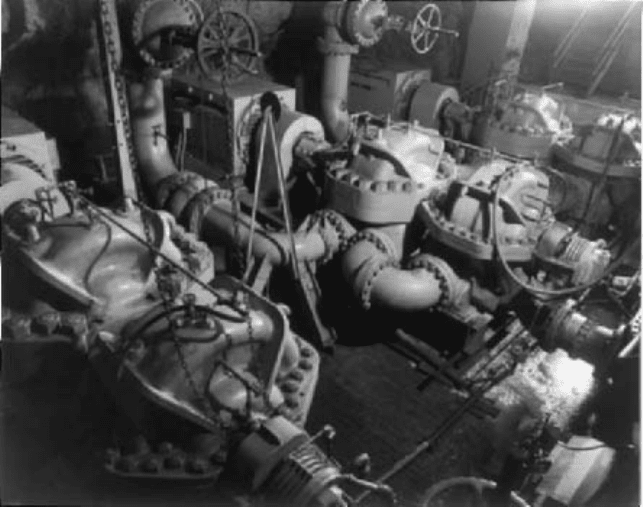
9.10 MINING 9.209
FIGURE 14 Three 2000 HP (1490 kW) pumps in one room in a zinc mine (Hazleton Pumps, Inc.)
Transient pressure pulsations have been experienced in low-pressure pumping sys-
tems. The danger here is that the low-pressure portion of the cycle will fall below atmos-
pheric pressure and the pipe will collapse.
Although any pumping system for mine service should be analyzed in detail for tran-
sient pressure pulsations, experience has shown that adequate air bottles have proved to
be one of the most effective and least expensive means of surge suppression. Slow-closing
valves and flywheels have been used, but they must be sized correctly. This is especially
true with high-speed pumps because these units possess little rotational inertia and will
decelerate very rapidly on shutdown, with accompanying high-pressure surge.
SUMPS _____________________________________________________________
Permanent sumps are seldom used in open-pit mines because the sump area generally
moves as the mining operation progresses. This means that the pump station must be
portable, and the installation of the pumps on a barge provides the most convenient
arrangement. Either horizontal or vertical pumps may be used, but vertical pumps elimi-
nate the need for priming equipment. If the vertical pumps are of the overhung-shaft
design, the stuffing box may be eliminated. This is important if the water is dirty. Although
small cyclones can be used to clarify the water for pumps that have stuffing boxes, care
must be taken to prevent leaves and other trash from blocking the gland water line. In
freezing climates, special provision must be made to prevent the suction line, pump, and
even the barge itself from freezing in place.
Underground mine sumps present special problems because they function not only as
sumps but also as clarifiers. A well-designed sump is a good clarifier, but all too frequently

9.210 CHAPTER NINE
TABLE 2 Materials of construction for mine pumps
Neutral waters Acidic waters Basic waters
Moderate High Moderate High Moderate High
heads heads heads heads heads heads
Casing Cast iron Ductile 316 S.S./ 17-4 PH Cast iron Ductile
iron/ alloy 20 iron/
cast steel cast steel
Impeller 28% Cr 28% Cr PH55A/ PH55A/
17-4PH 17-4PH
CD-4MCu CD4-MCu 28% Cr 28% Cr
Wear 28% Cr 28% Cr Same as Same as 28% Cr 28% Cr
rings impeller impeller
Shaft 28% Cr 28% Cr 316 or 316 or 28% Cr 28% Cr
sleeve or 303 or 303 alloy 20 alloy 20 or 303 or 303
S.S. S.S. ceramic- ceramic- S.S. S.S.
ceramic- ceramic- coated coated ceramic- ceramic-
coated coated PH55A, PH55A, coated coated
etc. etc.
Shaft Carbon High- 316 S.S./ 17-4 PH Carbon High-
steel tensile alloy 20 steel tensile
alloy steel alloy steel
Alloy 20 21% Cr 29% Ni 2.5% Mo
CD4-MCu 26% Cr 5% Ni 2.0% Mo
28% Cr 28% Cr
——
304 S.S. 19% Cr 10% Ni
—
316 S.S. 19% Cr 10% Ni 2.5% Mo
17-4 PH 17% Cr 4% Ni
—
Hardenable
PH55A 20% Cr 10% Ni 3.5% Mo Hardenable
inadequate provisions are made for cleaning the sump. If it is not cleaned at regular inter-
vals, the loss of storage capacity may be critical in the event of a power failure. Further-
more, a sump partially filled with solids does not give the proper retention time for
clarification, and the solids are directed into the pump. Although few sumps can econom-
ically be made large enough for complete clarification, it is important that a large portion
of the solids be removed. This is particularly true for 3600-rpm pumps because the high-
speed generally produces a high head per stage and the high differential pressure between
stages causes severe wear if abrasive solids are present. Some mines use conventional
thickeners and flocculating agents in an attempt to keep a high concentration of solids
from reaching the pump.
Some general rules should be considered in designing sumps for underground pump
rooms:
1. Attempt to get a complete analysis of the water (from another portion of the mine or
from an adjacent mine if necessary).
2. Analyze the sample for corrosive properties to determine the proper materials of con-
struction for the pump.
3. Analyze the sample for possible scale buildup in the pipeline and pumps. Check the
velocity effect, if any, on the buildup rate.
4. Determine the percentage of suspended solids in the sample, its screen analysis, and
the settling rate for various fractions. Determine the sump dimensions necessary for
removal of all solids and then for progressively larger solids in order to select the most
economical size.
9.10 MINING 9.211
5. Compare the sump size as determined in rule 4 with the size required for physical
storage capacity for (a) continuous pumping, (b) off-peak power pumping, (c) pro-
grammed pumping, and (d) storage during estimated maximum length of power
interruption.
6. Calculate practical sump dimensions, considering the geologic conditions.
7. Install grit traps ahead of the sump to remove large, heavy solids. Consider methods
for cleaning the grit traps.
8. Install trash screens to prevent wooden wedges, and so on from entering the sump.
9. Review sump cleaning methods and program. The best-designed sump is of no value
if it is not cleaned. Compare mechanical cleaning methods with cost of parallel sumps.
10. Review the suction requirements of the pumps to be used. Because of altitude, tem-
perature, distance from low water level to pump centerline, and suction line loss, the
available NPSH may be inadequate for even an 1800-rpm pump. If a decision as to
pump size, type, and speed has been made and an NPSH problem does exist, a deci-
sion must be made either to use low-speed booster pumps or to lower the pump room
level to below the sump level. From a safety standpoint, the use of a booster pump is
preferable, although it does add another piece of equipment.
11. Where the storage capacity is inadequate to meet possible power failures, consider
either vertical pumps
—
possibly up to 100 ft (30 m)
—
for the shaft bottom pumping up
to the main pump station level, or sealed pump rooms that can operate over wide vari-
ations in the sump level from a 15-ft (4.6-m) suction lift to a positive head of several
hundred feet.
12. Determine the final design based on a compromise between the mine engineer (who
wants maximum output), the electrical engineer (who wants small starting load), the
geologist (who wants small sump dimensions), and the mechanical engineer (who
wants the most reliable and easily maintained equipment).
AUTOMATIC PUMP CONTROL __________________________________________
With proper instrumentation, almost all pump stations can be operated automatically.
Remote monitoring is simple, relatively inexpensive, and can provide safe operation and
signaling of nearly all operating conditions. Equipment is presently available to measure,
record, and transmit the operating conditions to remote locations. The proper equipment
can thus relieve worry about the operation of the facility even if it is many miles from the
operation’s headquarters. Automatic control can be a simple float switch or a pressure
switch, or it can be sufficiently complex to provide reliable operation under the most crit-
ical or adverse conditions. Automatic control can provide greater reliability, and its cost
can depreciate over only a few years. Furthermore, the automatic recording of flow rate,
flow totalizing, and periods of operation provides valuable data for analyzing the perfor-
mance of the pumping installation as well as the possible cost savings in pumping during
off-peak power periods.
Where the safety of a mine is dependent on the reliable operation of the dewatering
pumps and controls, the following minimum requirements should be considered:
1. There should be a sump level alarm for high water, both local and remote (at the
surface).
2. Sump level control should be dependable. For example, electrodes are generally unre-
liable in waters that leave a conducting film.
3. The control should be programmed where more than one pump is installed. However,
the use of an alternator is not always desirable because all pumps are exposed to the
same degree of wear. It is preferable to have one standby pump programmed through
a sequence selection switch to operate at least once per week.
9.212 CHAPTER NINE
4. Pump priming should be positive. Hydraulic devices should be combined with electric
controls so complete dependence is not on the electric control. The presence of water
in the pump should be detected to prevent the starting of a dry pump.
5. A delay circuit should be provided to ensure complete priming.
6. The control should provide for at least three starting attempts (unless an overload has
occurred).
7. The priming time should be limited (if under a suction lift system).
8. The control should provide for a restart in the event of a false loss of prime on start-
up (suction lift system).
9. Pump and motor bearings should have thermostats to stop pumps in the event of
bearing failure.
10. Vibration monitoring may be important. This is particularly true for vertical pumps.
11. Pressure controls should indicate normal pressure and fail-safe in the event of a loss
of pressure (broken column line, and so on).
12. Flow indication (check valve flow switch) is needed to signal a shaft failure.
13. Remote indication (generally at the mine office) should provide at least an indication
of operation and signal pump failure or high water. More detailed information may be
transmitted.
14. For long distances, investigate the use of carrier-current indication schemes, together
with signal multiplexing, and so on.
15. Provide a method to test the control and alarm system.
DRIVERS ___________________________________________________________
Open-pit mines use electrically driven mining equipment, such as drag lines and shovels,
and the availability of power has permitted the use of electrically driven pumps. There are
still many gasoline-driven or diesel-driven units, but the convenience of electric power,
particularly for automatically controlled units, has increased the trend to electric drive.
The availability of reliable high-voltage cable has made portable high-voltage equipment
safe and economical. Pumps in open-pit service are seldom provided with sophisticated
control or drive mechanisms. The primary requirements are reliability, portability, and
wear resistance.
In locations where rainfall may be heavy and there is danger of power failure, a com-
bination of electric drive and engine drive is used. The engine can be direct-coupled to the
pump through a motor with a double-extended shaft or with a clutch between the engine
and the motor. Automatic control is simple and reliable.
Although some steam-driven pumps still exist in underground service, their number is
rapidly decreasing. Electric motor drive is the simplest for automatic control. Variable-
speed units, however, are seldom used in underground service because the ratio of static
head to total dynamic head is quite high. Thus the frictional loss is not a large percentage
of the total head loss and not much advantage is gained by variable speed. The solution is
usually a multiple-pump installation. This must be designed with care because it is possi-
ble to raise the frictional head to a point where an additional pump produces little addi-
tional capacity. Multiple discharge lines are the answer and are frequently used for safety
reasons. In normal service, all discharge lines are used in parallel, although conservative
design allows each line to handle the required capacity.
As with all pumping installations, a complete set of system-head curves must be pre-
pared to analyze the power requirements under all conditions.
Motor enclosures are important in underground service. Because of the high humidity,
special insulation (epoxy encapsulated, and so on) should be specified. Dripproof enclo-
sures are the minimum requirement, with weather-protected Type I the preferred con-
struction. Heaters should also be provided. Screens should be installed to prevent the
9.10 MINING 9.213
entrance of rats. Winding temperature detectors, bearing thermostats, and ground-fault
detectors are recommended in mine service and should be incorporated in the pump-
control and alarm circuits.
Although the starting torque of a centrifugal pump is low, the available torque may
have to be checked in some cases. A normal-torque motor should be suitable for pumps in
the range of 500 to 3000 (10 to 60) specific speed. High-specific-speed pumps, however,
have the highest power at shutoff, and it will be necessary to examine the starting
arrangements for such pumps.
Starting a pump against a long empty pipeline may present overload problems, and
repeated starts may be necessary. In such cases, the number of permissible starts per hour
should be checked. Winding temperature detectors are important in such applications.
Although reduced-voltage starters may be required in some instances, most modern
mines have electrical facilities designed for across-the-line starting. This is preferable
because the starting equipment is cheaper. Before deciding on a reduced-voltage starter,
the effect of the starting load on the transformer and line impedance should be checked.
It may be that the voltage drop will eliminate the requirement for reduced-voltage
starters. On the other hand, the effect on the primary side should be checked so the volt-
age drop is not so large as to drop out other equipment.
Synchronous-motor drives are seldom used unless they are large (generally at least
1000 hp) (750 kW) and then only if they are in relatively continuous service. Under such
conditions, they can be operated under “leading current” conditions for power factor cor-
rection. Smaller installations frequently provide capacitors at the pump installation to
provide the necessary correction for a particular installation.
Surge protection from lightning should not be overlooked. Some locations are particu-
larly susceptible to lightning damage, especially to long surface lines. Lightning arresters
should be provided at the surface, and surge arresters should be mounted at the motor
location.
REFERENCES _______________________________________________________
1. American National Standard for Centrifugal Pumps for Design and Application,
ANSI/HI 1.3-2000, Hydraulic Institute, Parsippany, NJ www.pumps.org.

WILLIAM J. SEMBLER
9.215
SECTION 9.11
MARINE PUMPS
Pumps used in marine shipboard applications, both commercial marine and Navy, can typ-
ically be divided into several groups. These groups include pumps associated with a ves-
sel’s propulsion, pumps used with the generators that produce electricity, pumps used in
ship’s service systems, pumps used to provide hotel services for crew and passengers, and
pumps that are used in cargo or other specialized systems.
Because marine pumps must operate on a moving platform, they should be designed
to withstand dynamic loads resulting from vessel motion (for example, pitch, roll, and so
on). In addition, they must often operate in a hot, humid, and potentially corrosive envi-
ronment. In addition, marine pumps must frequently be suitable to operate with a
range of flow rates to accommodate anything from operation of the vessel at full speed
to operation in port with the propulsion equipment secured. Furthermore, the mini-
mization of size (especially the required deck space) and weight is always important
when designing marine equipment. For this reason, many shipboard pumps are
mounted vertically (Figures 1 and 2), and smaller units are frequently furnished in a
close-coupled configuration (Figure 3) with the pump’s rotating parts mounted directly
on the driver’s shaft.To enable them to stand freely under pitch and roll conditions, ver-
tically mounted shipboard pumps often have larger bases than comparable shore-side
units.Typical materials used in the construction of marine centrifugal pumps are listed
in Table 1.
A description of the features typically incorporated into the designs of pumps used in
selected shipboard applications follows. This information is general in nature, however,
and may not apply in all cases based on the requirements for specific installations or the
preferences of vessel owners and designers.
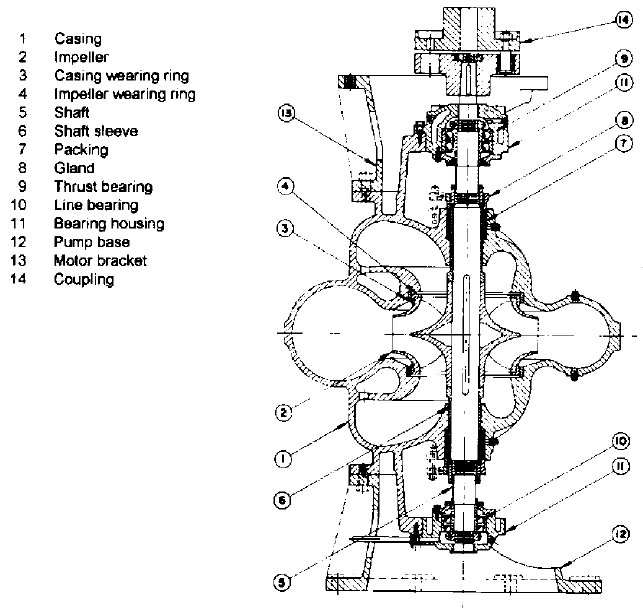
9.216 CHAPTER NINE
PROPULSION APPLICATIONS __________________________________________
Steam-Turbine-Propelled Vessels
FEED PUMPS A main feed pump is used to return water to a steam-powered vessel’s boil-
ers or steam generators. On a typical steam ship with fossil-fueled boilers, a main feed
pump takes suction from a deaerating feed tank (DFT) and discharges feedwater to the
steam drum in each of the vessel’s boilers. In many cases, a main feed pump’s discharge
is connected to two separate lines that both lead to the boilers: a main feed line and an
auxiliary feed line. In addition, the feedwater usually passes through one or more heaters
before entering the steam drums. Although a single feed pump is frequently sized to han-
dle a vessel’s full-load requirements, some ships have multiple partial-capacity feed
pumps that operate in parallel. Additional pumps are ordinarily provided for standby duty.
Typical feed pump configurations include single- and two-stage centrifugal pumps that
are close-coupled to steam turbines (Figure 4) and multistage flexibly coupled pumps that
are driven by steam turbines or electric motors. Although flexibly coupled feed pumps
often have cast axially split volute-type casings (Figure 5), barrel pumps with diffusers
and forged cylindrical casings are sometimes used. Turbine-driven feed pumps are usually
mounted horizontally. Motor-driven feed pumps, however, have been used in both hori-
zontal and vertical configurations.
FIGURE 1 Vertical between-bearings centrifugal pump (Flowserve Corporation)
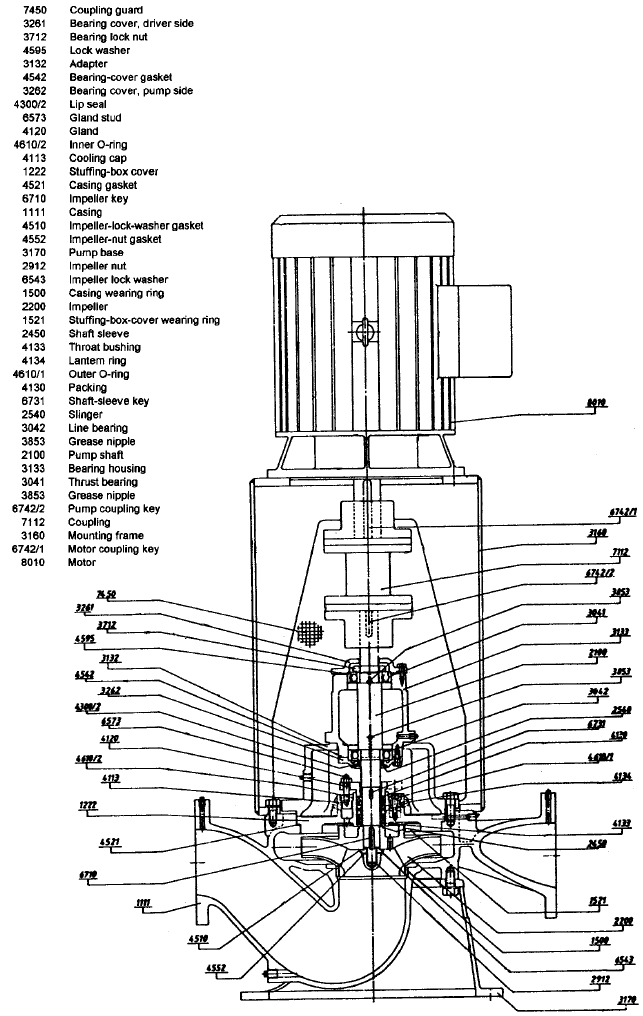
9.11 MARINE PUMPS 9.217
FIGURE 2 Vertical back-pull-out centrifugal pump (Flowserve Corporation)
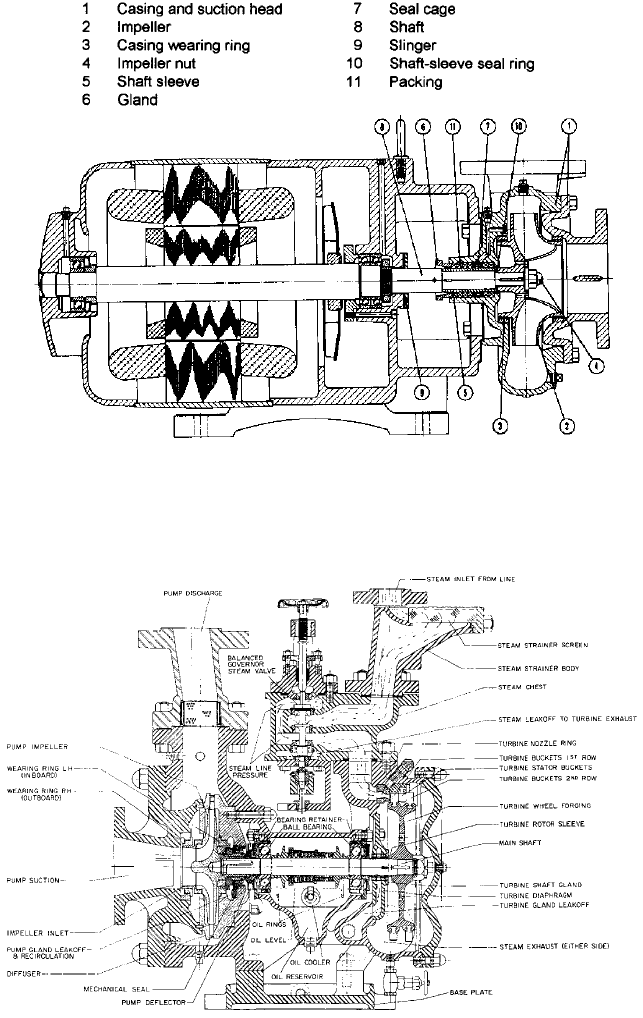
9.218 CHAPTER NINE
FIGURE 4 Close-coupled single-stage centrifugal main feed pump (Coffin Turbopump)
FIGURE 3 Horizontal close-coupled centrifugal pump (Flowserve Corporation)
